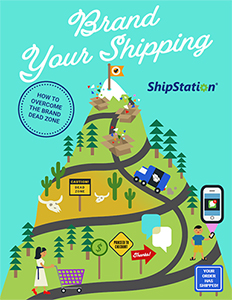Managing Online Shipping & Returns Expectations

How do you offer generous shipping and returns policies on your website to help first-time visitors feel more at ease about buying from an unknown brand, and do so without going broke?
Shipping and Returns Expectations
Robert Gilbreath was an early eBay adopter and worked for several Internet Retailer Top 500 retailers before joining ShipStation, a leading web-based ecommerce shipping solution where he’s now Chief Marketing Officer and Vice President of Partnerships.
Read Robert's blogs on Shipstation
We asked him for tips on managing shopper expectations around shipping and returns.
Making Free Shipping Profitable
Gilbreath said many case studies show how offering free shipping increases sales, but sales without profits don’t make sense.
Here are some steps merchants should take to explore how low or free shipping can increase profits on their website:
- Test: Compare conversion rates with and without a free shipping offer.
- Create Thresholds: Increase the minimum order value required for free shipping. (“Free shipping on orders over $50,” for example.)
- Set Restrictions: See what kind of improvement you’ll get by offering free shipping only on select products where it is profitable.
- Increase Price: Increase all your product prices to compensate for the loss you take on free shipping, and see how your profit compares.
- Offer only ground shipping: Studies show many online shoppers are willing to wait longer for delivery of an order in exchange for free shipping. Most shoppers are likely to choose the free shipping option. By using only ground shipping, you could cut your free shipping expense by over 50%.
Rethinking Returns
No seller likes returns, in fact, they're becoming even more of a touchy subject than free shipping these days, but Gilbreath said ShipStation has seen how return policies can actually help small businesses.
Consider the following tips:
- Provide important information upfront to decrease returns. One merchant changed the way they presented size information on their Tshirts to help customers order the correct size the first time. Size and color issues are the #1 reason for returns in apparel, according to ShipStation.
- Optimize your packaging to reduce returns by better protecting items during shipping.
- Skip restocking fees if you want to connect with buyers – if you must, charging return shipping, which gives you more leeway; you can choose not to charge customers the full cost of the shipping label.
- If you don’t offer free returns, make sure there is messaging to the consumer about what they should do if they are unhappy. Offer them an easy way to get help, such as live chat. Sometimes the retailer can help the customer so a return becomes unnecessary.
- Consider free exchanges.
For most products, there’s an expectation of free returns, Gilbreath said, but sellers who offer unique items that aren’t available elsewhere can worry less about such expectations – for example, handcrafted or personalized goods.
Offering a Branded Returns Portal
ShipStation offers sellers the ability to set up a Branded Returns Portal on their websites at no cost. ShipStation tries to help makes small sellers look like big sellers, Gilbreath said. Sellers can also present branded tracking pages to customers.
Here are some of the results ShipStation has seen from retailers who offer a branded returns portal
- After ShipStation merchants implemented the Branded Returns Portal, the median increase for average order volume per store was 16%
- A satisfactory returns experience increases repeat purchases. ShipStation reviewed the rates of repeat purchases before and after stores launched their Branded Returns Portal and found shoppers were 28.8% more likely to order from the same merchant again after returning an item through a self-service portal.
- Using the self-service returns portal had a substantial impact on smaller business in particular. Prior to implementing the Branded Returns Portal, only 15.5% of customers who made a return bought from the retailer again. However, once retailers launched the self-service returns portal, repeat purchases from returners increased by 63%. This dramatic increase wasn’t seen with higher-volume sellers but they still saw a solid 10% increase.
Shipping Internationally
Shipping internationally comes with additional challenges. Gilbreath said ShipStation had so much interest in the topic that it published free downloadable PDF guide called “International Shipping Essentials” to answer sellers’ questions.
Holiday Shipping
With Christmas just days away, we asked Gilbreath if he had any tips for holiday shipping. He provided us with a roundup of past blog posts to help sellers prepare for the holiday rush.
5 Ways to Prepare Your Packing and Shipping Area for the Holiday Rush
4 Vital Holiday Marketing Tips for Online Retailers
4 Totally Preventable Cyber Monday Mistakes and How to Avoid Them
3 Essential Parts of Exceptional Black Friday Marketing
About ShipStation
ShipStation is the leading web-based shipping solution that helps e-commerce retailers import, organize, process, and ship their orders quickly and easily from any web browser. ShipStation features the most integrations of any e-commerce web-based solution with over 150 shopping carts, marketplaces, package carriers, and fulfillment services. ShipStation’s many integration partners include eBay, Jet, PayPal, Amazon, Etsy, BigCommerce, WooCommerce, Shopify Plus, Squarespace, Volusion, and Magento. ShipStation also integrates with carriers such as SEKO Logistics, DHL, FedEx, USPS, UPS, Canada Post, Australia Post, Royal Mail, and Hermes. ShipStation has sophisticated automation features such as automated order importing, custom best practice rules, product profiles, and fulfillment solutions that enable its users, wherever they sell and however they ship, to be exceptionally efficient at shipping orders. ShipStation is a wholly-owned subsidiary of Stamps.com (Nasdaq: STMP).
Related: Providing eCommerce Merchants Access to Cross-Border & International Parcel Solutions
Related eBook
Brand Your Shipping - How to Overcome the Brand Dead Zone
Learn how to effectively market your brand in a way that will provide a positive experience and establish a strong connection between you and your customers at every step of the shipping process. Download Now!
Article Topics
ShipStation News & Resources
ShipStation report examines holiday season shopping preferences ShipStation welcomes SEKO’s LTL capabilities for its partner network ShipStation research looks at consumer shipping expectations amid COVID-19 pandemic USPS’s service suspension in some global markets creates challenges for e-commerce shippers Onnit Customer Success Story with SkuVault Warehouse Management System Brand Your Shipping - How to Overcome the Brand Dead Zone Managing Online Shipping & Returns Expectations More ShipStationLatest in Transportation
Why are Diesel Prices Climbing Back Over $4 a Gallon? Luxury Car Brands in Limbo After Chinese Company Violates Labor Laws The Three Biggest Challenges Facing Shippers and Carriers in 2024 Supply Chain Stability Index: “Tremendous Improvement” in 2023 Trucking Association CEO on New Biden Policy: ‘Entirely Unachievable’ Two Weeks After Baltimore, Another Cargo Ship Loses Power By Bridge Examining the freight railroad and intermodal markets with Tony Hatch More Transportation















